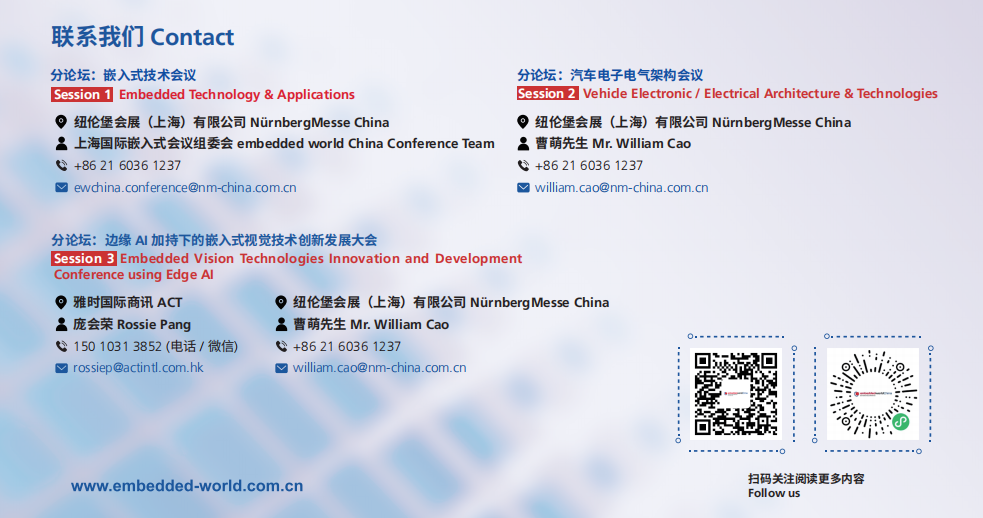Topic: Embedded Operating Systems
1. Embedded Multi-core Operating System for Intelligent Systems
Prof. ALLAN HE, Embedded System Associations
The rapid deployment of artificial intelligence technology at the edge and on-device is driven by large models, and the research and application of high-performance heterogeneous multi-core embedded processors and microcontroller chips are quickly becoming widespread in intelligent systems represented by smart cars and robots. Although operating system technologies have mature solutions for heterogeneous multi-core chips, they still face numerous challenges in terms of real-time performance, safety, and cost-effectiveness. The presentation outlines three technical paths for multi-core embedded operating systems – AMP, SMP, and virtualization principles and implementation solutions, showcasing development and programming examples of multi-core embedded operating systems based on open-source FreeRTOS, Thread-X RTOS, and the open-source lightweight embedded hypervisor Bao. Finally, it introduces typical applications of the open-source openEuler multi-core operating system in mixed-criticality systems, while discussing its limitations and practical application challenges.
2. Open Source Hybrid Kernel OS Introduction: RT-Smart
Bingru Zhang, RT-Thread
1) The Background of RTOS
Real-Time Operating Systems (RTOS) are the backbone of embedded systems, providing deterministic task scheduling and execution critical for time-sensitive applications.
2) What is the Hybrid Kernel OS
A Hybrid Kernel OS combines the strengths of microkernel and monolithic kernel architectures to offer a balanced solution. It integrates the efficiency and performance of monolithic kernels with the modularity and fault isolation of microkernels, creating an operating system architecture optimized for flexibility, reliability, and scalability.
3) Why It is Being Created
The need for a Hybrid Kernel OS stems from challenges in modern embedded systems; developers require an OS that can efficiently support real-time performance while accommodating advanced features like multi-threading, resource sharing, and interoperability with legacy systems.
4) What Challenges It Solves
The Hybrid Kernel OS addresses critical challenges in embedded systems, including:
Bridging the gap between real-time performance and multi-functional capability.
Enhancing system stability and reliability through modular architecture.
5) RT-Smart Introduction & Its Architecture
RT-Smart is an open-source Hybrid Kernel OS designed to meet the dynamic needs of the embedded systems community. It combines the advantages of traditional RTOS with a hybrid kernel architecture to deliver a robust, flexible, and efficient solution.
3. Security Implementation and Application of Pre-Certified RTOS
Aihua Zhang, Beijing Maikete Software Technology Co., Ltd.
Concept of Functional Safety (including SIL level classification…)
IEC61508 Software Safety Requirements
Functional Safety RTOS
Hardware Requirements for Safety RTOS
Methods and Processes for Pre-Certification of RTOS
Risk Analysis and Assessment Based on IEC62443
Products and Applications of Pre-Certified RTOS
4. DIGI Embedded Platform AI SolutionsBin Zhang, Digi International China
ConnectCore SOM
❑ Big.LITTLE architecture, small coresMCUhandles real-time tasks, large cores/multi-core processing communications, protocols,AI/MLand other tasks.
❑ Free development resources for the development board, including circuit schematics,PCBpackaging,BOMlist,BSPsource code, etc., with rich examples and detailed development documentation.
❑ User-friendlySmartIOMuxand other development tools simplify development work, accelerate development progress, and support container-based deployment of the development environment.
❑ Multi-platform support forLinux,Android, andWindows IoT platforms.
❑ Integration of rich third-party libraries for rapid application development (Qt6,LVGL,Crank Storyboard,Webkit, offline voice recognition libraries,ROS…)
❑ Support for third-party cloud platforms such asAzure, AWS, etc.
❑ ProvidesCCSS services to meet compliance requirements for safety in Europe and the United States.
❑ Continuous system upgrades enhance security and the richness, usability, and characteristics of the ecosystem.
❑ Standard packaging for easy product upgrades.
❑ Long-term supply guarantee.
Digi Embedded Yocto (DEY 4.0-r5 LTS)
Windows 11 IoT Enterprise for ConnectCore
Digi Embedded Android (DEA-14.0-r2)
Digi ConnectCore Smart IOmux
Digi IoT Device Simulator
Cloud Services – IoT Fleet Management
Cloud services and security services
Digi ConnectCore cloud services
Digi TrustFence® security framework
ConnectCore security services
Security services include
• Security vulnerability analysis before and after customer product release.
• Identification of security vulnerabilities.
• Support for SBOM management.
• Scanning of binary files to analyze security risks.
• Security monitoring and maintenance throughout the product lifecycle.
• Consulting services to help fix security vulnerabilities.
Common GUI Frameworks in Embedded Development
Several of the most common UI frameworks
1. LVGL
Open-source (MIT), lightweight, rich graphical elements and themes, cross-platform, very suitable for resource-constrained embedded systems.
2. Qt
Qt is a large C++ functional library, with two systems: qml and widgets, available under both open-source and commercial licenses.
3. Crank Storyboard by Cranksoftware
Storyboard is a dedicated platform for rapid UI development and performance optimization, developed from a designer’s perspective to create embedded UIs without coding, enabling animations, sliding menus, 3D effects, etc.
4. Webkit WPE (wpewebkit.org)
WPE is the official version of the open-source web browser engine WebKit ported to embedded platforms, designed specifically for embedded systems as it does not rely on any user interface toolkit, using web technologies to implement various graphics and menu displays, 3D animations, video effects, etc.
Embedded GUI frameworks require embedded system-level support.
• BSP support is required to utilize hardware decoding capabilities such as GPU/VPU/CAAM; otherwise, it will fall back to the CPU.
• The software dependencies and libraries required by the GUI framework need to be integrated into the root filesystem of the embedded device.
• The system image must be reasonably optimized to minimize storage and memory usage while providing support.
Implementing different GUI frameworks and utilizing hardware capabilities for interface rendering presents certain challenges for system developers!
Application of Container Technology in Embedded Development
Challenges faced by developers
• Computer configuration and upgrade issues.
• Conflicts arising from multiple development environments coexisting.
• How to quickly roll back or redeploy the development environment.
DEY supports deploying the development environment using containers.
